产品中心
当前位置:首页>产品中心Anti-Cyclin E1
货号: bs-0573R 基本售价: 380.0 元 规格: 20ul
- 规格:20ul
- 价格:380.00元
- 规格:50ul
- 价格:780.00元
- 规格:100ul
- 价格:1380.00元
- 规格:200ul
- 价格:2200.00元
产品信息
- 产品编号
- bs-0573R
- 英文名称
- Cyclin E1
- 中文名称
- 周期素E抗体
- 别 名
- CCNE 1; CCNE; CCNE1; Cyclin E1; Cyclin Es; Cyclin Et; CyclinE; G1/S specific cyclin E; G1/S-specific cyclin-E1; CCNE1_HUMAN.

- Specific References (2) | bs-0573R has been referenced in 2 publications.[IF=2.88] Xu, X., et al. "Concentration-Dependent Diversifcation Effects of Free Cholesterol Loading on Macrophage Viability and Polarization." Cellular Physiology and Biochemistry 37.2 (2015): 419-431. WB ; Mouse.PubMed:26314949[IF=3.13] Zhang, Wen-feng, et al. "Angelica polysaccharides inhibit the growth and promote the apoptosis of U251 glioma cells in vitro and in vivo." Phytomedicine (2017). WB ; Human.PubMed:0
- 规格价格
- 50ul/780元购买 100ul/1380元购买 200ul/2200元购买 大包装/询价
- 说 明 书
- 50ul 100ul 200ul
- 研究领域
- 细胞生物 细胞周期蛋白
- 抗体来源
- Rabbit
- 克隆类型
- Polyclonal
- 交叉反应
- Human, Mouse, Rat,
- 产品应用
- WB=1:500-2000 ELISA=1:500-1000 IHC-P=1:400-800 IHC-F=1:400-800 Flow-Cyt=1μg/Test IF=1:100-500 (石蜡切片需做抗原修复)
not yet tested in other applications.
optimal dilutions/concentrations should be determined by the end user.
- 分 子 量
- 45kDa
- 细胞定位
- 细胞核
- 性 状
- Lyophilized or Liquid
- 浓 度
- 1mg/ml
- 免 疫 原
- KLH conjugated synthetic peptide derived from rat Cyclin E:375-411/411
- 亚 型
- IgG
- 纯化方法
- affinity purified by Protein A
- 储 存 液
- 0.01M TBS(pH7.4) with 1% BSA, 0.03% Proclin300 and 50% Glycerol.
- 保存条件
- Store at -20 °C for one year. Avoid repeated freeze/thaw cycles. The lyophilized antibody is stable at room temperature for at least one month and for greater than a year when kept at -20°C. When reconstituted in sterile pH 7.4 0.01M PBS or diluent of antibody the antibody is stable for at least two weeks at 2-4 °C.
- PubMed
- PubMed
- 产品介绍
- background:
The protein encoded by this gene belongs to the highly conserved cyclin family, whose members are characterized by a dramatic periodicity in protein abundance through the cell cycle. Cyclins function as regulators of CDK kinases. Different cyclins exhibit distinct expression and degradation patterns which contribute to the temporal coordination of each mitotic event. This cyclin forms a complex with and functions as a regulatory subunit of CDK2, whose activity is required for cell cycle G1/S transition. This protein accumulates at the G1-S phase boundary and is degraded as cells progress through S phase. Overexpression of this gene has been observed in many tumors, which results in chromosome instability, and thus may contribute to tumorigenesis. This protein was found to associate with, and be involved in, the phosphorylation of NPAT protein (nuclear protein mapped to the ATM locus), which participates in cell-cycle regulated histone gene expression and plays a critical role in promoting cell-cycle progression in the absence of pRB. Two alternatively spliced transcript variants of this gene, which encode distinct isoforms, have been described. Two additional splice variants were reported but detailed nucleotide sequence information is not yet available. Transcript Variant: This variant (1) contains a different 5 end region, which includes an upstream in-frame translation start codon, when compared to variant 2. The encoded protein has a 15 aa longer N-terminus, as compared to isoform 2.
Subunit:
Interacts with a member of the CDK2/CDK protein kinases to form a serine/threonine kinase holoenzyme complex. The cyclin subunit imparts substrate specificity to the complex. Found in a complex with CDK2, CABLES1 and CCNA1 (By similarity). Part of a complex consisting of UHRF2, CDK2 and CCNE1. Interacts directly with UHRF2; the interaction ubiquitinates CCNE1 and appears to occur independently of CCNE1 phosphorylation.
Subcellular Location:
Nucleus.
Tissue Specificity:
Highly expressed in testis and placenta. Low levels in bronchial epithelial cells.
Post-translational modifications:
Phosphorylation of Thr-395 by GSK3 and of Ser-399 by CDK2 accelerates degradation via the ubiquitin proteasome pathway. Phosphorylated upon DNA damage, probably by ATM or ATR.
Similarity:
Belongs to the cyclin family. Cyclin E subfamily.
SWISS:
P39949
Gene ID:
25729
Database links:Entrez Gene: 898 Human
Entrez Gene: 12447 Mouse
Entrez Gene: 25729 Rat
Omim: 123837 Human
SwissProt: P24864 Human
SwissProt: Q61457 Mouse
SwissProt: P39949 Rat
Unigene: 244723 Human
Unigene: 16110 Mouse
Unigene: 15455 Rat
Important Note:
This product as supplied is intended for research use only, not for use in human, therapeutic or diagnostic applications.
细胞周期素E是调控细胞G-1→S期转变的关键因素。由于在多种肿瘤中的不适当表达,细胞周期素E现在已明确为原癌基因。
- 产品图片
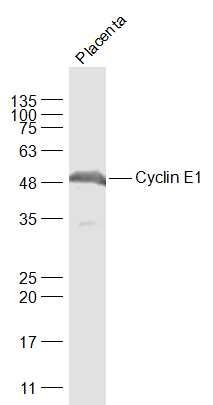 Sample:
Sample:
Placenta (Mouse) Lysate at 40 ug
Primary: Anti-Cyclin E1 (bs-0573R) at 1/1000 dilution
Secondary: IRDye800CW Goat Anti-Rabbit IgG at 1/20000 dilution
Predicted band size: 45 kD
Observed band size: 48 kD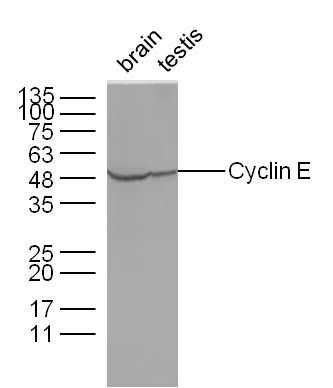 Sample:
Sample:
Brain(Mouse) Lysate at 40 ug
Testis(Mouse) Lysate at 40 ug
Primary: Anti-Cyclin E (bs-0573R) at 1/300 dilution
Secondary: IRDye800CW Goat Anti-Rabbit IgG at 1/10000 dilution
Predicted band size: 45 kD
Observed band size: 48 kD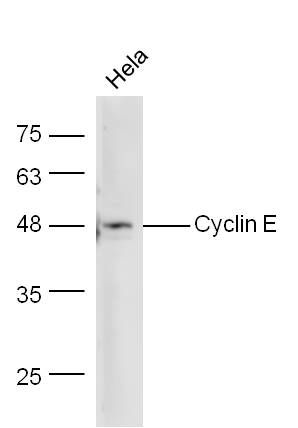 Sample: Hela Lysate at 40 ug
Sample: Hela Lysate at 40 ug
Primary: Anti-Cyclin E (bs-0573R) at 1/300 dilution
Secondary: IRDye800CW Goat Anti-Rabbit IgG at 1/10000 dilution
Predicted band size: 45 kD
Observed band size: 48 kD Sample:
Sample:
Brain(Rat) lysate at30ug;
Lung(Rat) lysate at 30ug;
Primary: Anti-Cyclin E (bs-0573R) at 1:200;
Secondary: HRP conjugated Goat-Anti-Rabbit IgG(bse-0295G) at 1: 3000;
Predicted band size : 45kD
Observed band size : 45kD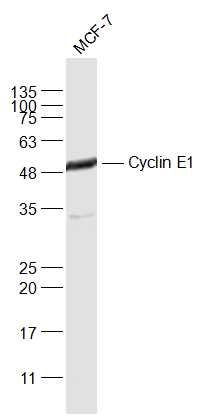 Sample:
Sample:
MCF-7(Human) Cell Lysate at 30 ug
Primary: Anti-Cyclin E1 (bs-0573R) at 1/1000 dilution
Secondary: IRDye800CW Goat Anti-Rabbit IgG at 1/20000 dilution
Predicted band size: 45 kD
Observed band size: 48 kD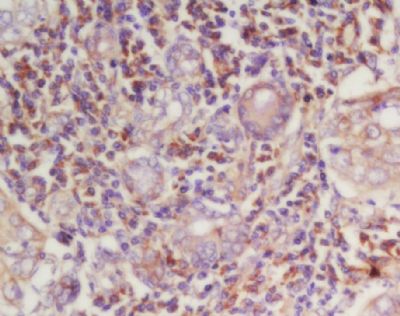 Tissue/cell: human laryngocarcinoma; 4% Paraformaldehyde-fixed and paraffin-embedded;
Tissue/cell: human laryngocarcinoma; 4% Paraformaldehyde-fixed and paraffin-embedded;
Antigen retrieval: citrate buffer ( 0.01M, pH 6.0 ), Boiling bathing for 15min; Block endogenous peroxidase by 3% Hydrogen peroxide for 30min; Blocking buffer (normal goat serum,C-0005) at 37℃ for 20 min;
Incubation: Anti-Cyclin-E Polyclonal Antibody, Unconjugated(bs-0573R) 1:200, overnight at 4°C, followed by conjugation to the secondary antibody(SP-0023) and DAB(C-0010) staining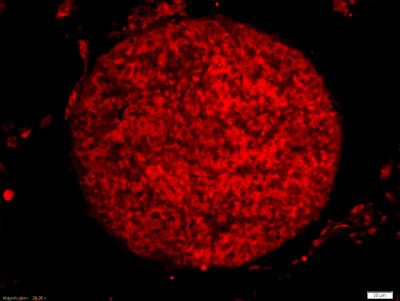 Tissue/cell: rat testis tissue;4% Paraformaldehyde-fixed and paraffin-embedded;
Tissue/cell: rat testis tissue;4% Paraformaldehyde-fixed and paraffin-embedded;
Antigen retrieval: citrate buffer ( 0.01M, pH 6.0 ), Boiling bathing for 15min; Blocking buffer (normal goat serum,C-0005) at 37℃ for 20 min;
Incubation: Anti-Cyclin E Polyclonal Antibody, Unconjugated(bs-0573R) 1:200, overnight at 4°C; The secondary antibody was Goat Anti-Rabbit IgG, Cy3 conjugated(bs-0295G-Cy3)used at 1:200 dilution for 40 minutes at 37°C.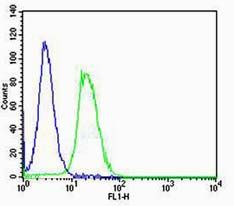 Cell: NIH/3T3
Cell: NIH/3T3
Concentration:1:100
Host/Isotype:Rabbit/IgG
Flow cytometric analysis of primary antibody (Cat#: bs-0573R) on NIH/3T3(green) compared with Rabbit IgG isotype control in the absence of primary antibody (blue) followed by Alexa Fluor 488-conjugated goat anti-rabbit IgG(H+L) secondary antibody .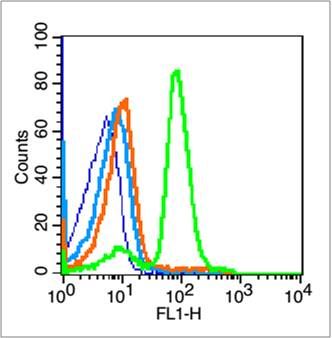 Blank control (blue line): Mouse spleen cells (blue).
Blank control (blue line): Mouse spleen cells (blue).
Primary Antibody (green line): Rabbit Anti-Cyclin E1 antibody (bs-0573R)
Dilution: 1μg /10^6 cells;
Isotype Control Antibody (orange line): Rabbit IgG .
Secondary Antibody (white blue line): Goat anti-rabbit IgG-FITC
Dilution: 1μg /test.
Protocol
The cells were fixed with 70% ethanol (overninght at 4℃) and then permeabilized with 0.1% PBS-Tween for 20 min at room temperature. Cells stained with Primary Antibody for 30 min at room temperature. The cells were then incubated in 1 X PBS/2%BSA/10% goat serum to block non-specific protein-protein interactions followed by the antibody for 15 min at room temperature. The secondary antibody used for 40 min at room temperature. Acquisition of 20,000 events was performed.

